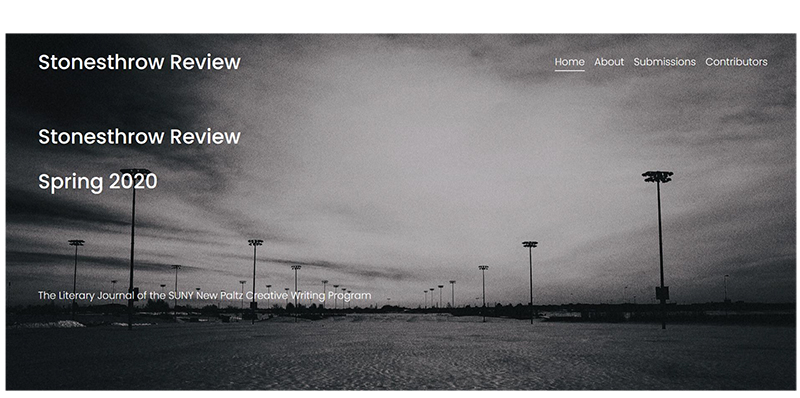Stonesthrow Review Moves Online Amid COVID Remote Learning Transition
Amidst the transition from in-person to remote instruction during the spring 2020 semester, the Stonesthrow Review, a literary journal for student writing and managed by the English Department’s Creative Writing Program, was reborn as a web publication for its 15th issue.
The Stonesthrow Review publishes a variety of undergraduate student writing, including poetry, short fiction, creative nonfiction and graphic narratives. Submissions are open to all SUNY New Paltz undergraduate students and represent a variety of disciplines throughout the College, though a majority do come from the English Department.
Stonesthrow began as a print publication in 2005, and while print will continue to remain a priority once the restrictions of COVID abate, creating a suitable web version of the journal had long been a topic of discussion. Previous web incarnations included a PDF of the print version housed on the English Department webpage as well as a more limited website built using Word Press. Upon these foundations, the current version of the online literary journal was born.
This past spring, just around the time that the COVID pandemic sent everyone home to work remotely, the English Department had a finished proof of the Stonesthrow Review ready to go to press, when funding for printing was restricted due to budgetary concerns. Working creatively to provide the students with an alternative, faculty and staff worked to create a better version of the existing website – this one designed specifically for digital publication using the economical Squarespace platform.

Kristopher Jansma, associate professor of English, directs the Creative Writing Program and serves as the Stonesthrow Review’s editor. Jansma hopes to continue to publish Stonesthrow online throughout the pandemic but also to continue it in tandem with a print version once normal campus operations resume.
“Every writer has a dream of holding the first printed copy of their work in their hands,” Jansma noted.
In the meantime, Jansma enjoys exploring the versatility of the website, which among other benefits, allows for the pairing of images and writing. In past years, Jansma reached out to the Art Department for black and white student artwork to appear on the cover of the print publication. While the print version could not accommodate images in the main part of the journal, the online version has opened up this possibility. For the online publication, Jansma used Creative Commons licensed imagery to make appropriate matches to the writing. In some instances, the student writers provided their own images or the fellow classmates’ artwork that they felt paired well with their work.
Future goals for the journal include a more focused, collaborative partnership with students and authors. “I love being able to pair images with the writing pieces. I think that is a fun and interesting way to draw viewers into the publication and the online format allows for this in a way that the print version didn’t allow,” said Jansma.
Another new addition to Stonesthrow could include opportunities for independent study.
“One of my goals for this spring is to create an independent study for a few of the graduate students in the new MA with a concentration in creative writing program to collaborate within the process of putting the magazine together so that they could learn more about the editorial process,” Jansma said. This would allow students to learn about the entire process of journal creation, including submission selection, image pairing, layout and web maintenance.
Yet another potential learning opportunity is presented by the change in medium from print to web, as students become aware of the ramifications of having their writing live online indefinitely. This may present an issue for those who had submitted incredibly personal stories, though students do have the option of using a pen name in place of their real name.
“Once it’s online it really is public in a way that the printed version never used to be,” noted Jansma. “It changes the nature of things a bit. It really is published in a fully public way once it’s online. This is something that I speak to my students about in class – the difference between writing something that you are happy to share in a workshop versus taking that same piece and putting it on the internet forever. It’s a different decision.”
Throughout this inaugural issue of the Stonesthrow Review, tributes to the late Creative Writing Professor and former Stonesthrow Review Editor Pauline Uchmanowicz abound. In the wake of her passing, Jansma and the students wanted to celebrate the indelible impact she made on the program, her students and colleagues.
The very first essay in the Stonesthrow Review is a letter titled The Mystic, submitted by Uchmanowicz’s partner Jim Spencer. The piece includes a draft version of a final poem of hers:
The Mystic
By Pauline Uchmanowicz
Legerdemain, possibly,
was her sideline—now you
see it, now you—deft
as a casino dealer,
smooth as scotch
she shuffled, eyes
directed heavenward,
tossing off divination
easily as texting.
After my cut, deck
spread across a baize
tabletop, she instructed
pick three,_her
incense vision of
my future all pasty
and lightning bugs, tandem
bicycles and ice fishing.
My lifeline, on the other hand,
kept predicting, time’s up.
Jansma, in his Editor’s Note on the front page of the journal, speaks reverently of Uchmanowicz.
“She had long been a champion of our program’s students and their work, and this, our 15th annual issue of Stonesthrow Review, is dedicated to her,” he wrote .

